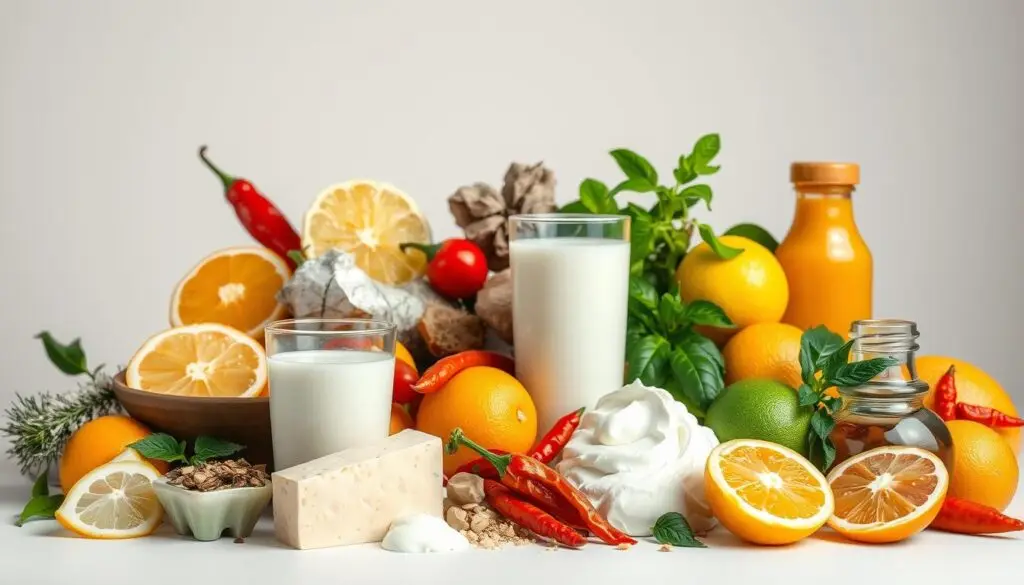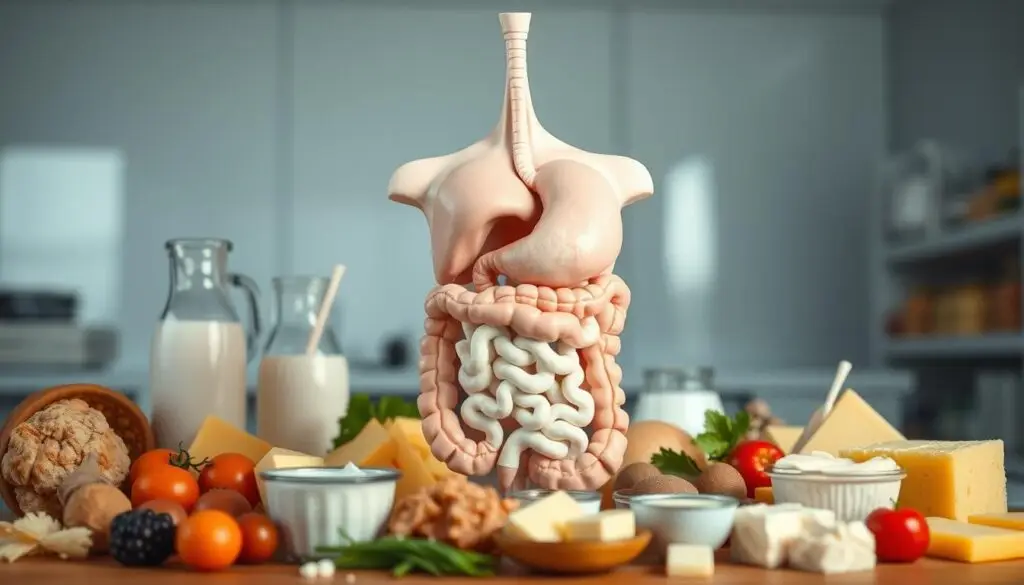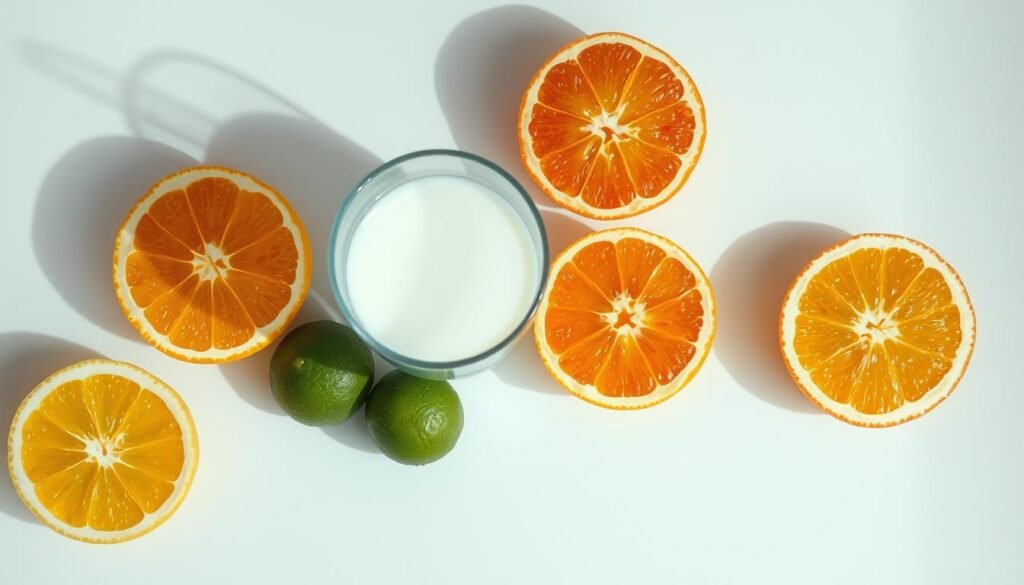Unexpected foods to never pair with milk! Learn how these combinations can harm digestion and health. Stay informed.

Table of Contents
5 Unexpected Foods That Milk Should Never Pair With

Did you know some common foods can turn a simple glass of milk into a digestive dilemma? Mixing milk with certain ingredients might disrupt your body’s ability to absorb nutrients. This can cause bloating, stomachaches, or other discomfort. This article reveals five everyday foods—from citrus to fermented items—that clash with milk, explaining why they’re on the list of foods to avoid with milk.
Milk and food pairing tips are crucial for maximizing nutritional benefits. By understanding these combinations, you can protect your digestion. Enjoy milk’s calcium and vitamins without hidden risks. From ancient cultural wisdom to modern science, this guide shows how mindful choices transform your daily diet.
Key Takeaways
- Milk reacts poorly with citrus, fish, bananas, spicy foods, and fermented items.
- Ignoring these foods to avoid with milk may lead to digestive issues.
- Simple milk and food pairing tips reduce discomfort and boost nutrient absorption.
- Cultural traditions and scientific research both warn against these combinations.
- Adjusting your choices can help you enjoy milk’s benefits without compromising health.
Understanding the Science Behind Foods to Avoid with Milk
When you mix milk with certain foods, your body has trouble breaking down nutrients. The proteins, fats, and sugars in milk react differently with other ingredients. This can cause digestion issues with milk.

How Milk Interacts with Other Foods in Your Digestive System
Milk has casein proteins and lactose that need specific enzymes to digest. When you eat acidic foods like citrus or fermented items, your stomach’s pH changes. This slows down enzyme work, leaving nutrients undigested. This can lead to bloating or gas.
The Role of Enzymes in Milk Digestion
- Lactase breaks down lactose, the sugar in milk.
- Lipase processes fats like those in dairy.
- Proteases tackle casein proteins.
When foods block these enzymes, your body can’t absorb nutrients well. This makes dairy and digestion problems worse.
Why Certain Food Combinations Cause Digestive Distress
Some foods overwhelm your digestive system. For instance, fish and dairy need different enzymes. This can make your system work too hard, leading to cramps or indigestion. Knowing how these biochemical processes work helps you stay away from foods to avoid with milk that upset your gut’s balance.
The Impact of Improper Milk Pairings on Your Health
Not pairing milk correctly can cause more than just a little discomfort. Many people get milk intolerance symptoms like bloating, gas, or cramps. This happens when they mix milk with foods like citrus or fish. These signs might seem small but could mean bigger digestive problems.

- Bloating and sharp abdominal pain
- Frequent gas or nausea after meals
- Diarrhea or irregular bowel movements
These wrong pairings can mess with your gut bacteria and lower nutrient absorption. They can also cause inflammation. Long-term milk intolerance symptoms might lead to vitamin deficiencies or digestive disorders. Also, milk and stomach upset can weaken your immune system by stressing your digestive system.
Watching how you react to food can help avoid long-term health issues. Keep a food diary to find out which pairings upset your stomach. This way, you can avoid health problems in the future.
Citrus Fruits and Milk: A Problematic Combination
Eating citrus fruits with milk can cause stomach problems. The acids in fruits like oranges and lemons mix with milk proteins. This mix is hard for your body to digest. It’s one of the main foods to avoid with milk for better digestion.

The science behind it is about pH levels. Citrus juices have a pH under 3, much lower than milk’s neutral pH of around 6.5. Here’s how they clash:
| Fruit | pH Level | Effect on Milk |
|---|---|---|
| Lemon | 2.0–2.5 | Immediate protein clumping |
| Orange | 3.0–3.5 | Mild to moderate curdling |
| Grapefruit | 2.5–3.0 | Protein breakdown in stomach |
When eaten together, these acids make your stomach work harder. This strain often leads to milk and stomach upset. Common signs include:
- Bloating and gas
- Nausea or acid reflux
- Cramping or diarrhea
Many think curdling only happens in a glass, but it also happens in your gut. Even small amounts can upset digestion, especially if you have a sensitive stomach. It’s best to pair milk with non-acidic foods like oats or cereal to avoid these problems.
Fish and Dairy: The Ayurvedic Wisdom Behind This Forbidden Pairing
Ayurvedic traditions warn against mixing fish and dairy. They say it can upset your digestion. This ancient advice is now backed by science, showing why mixing these can cause problems.
Historical Perspectives on Fish and Milk Combinations
Old texts like the Charaka Samhita say fish and dairy are not good together. They have different energies. This mix can lead to digestive issues, as seen in India and Greece.
Modern Scientific Explanations for This Food Taboo
Scientists look at how proteins interact. Fish enzymes can break down milk proteins, making them hard to digest. This can cause bloating or gas, common dairy and digestion problems.
- Salmon and yogurt: High mercury in fish may bind with calcium in milk, reducing absorption.
- Cheese with sushi: Enzymes in raw fish can curdle milk proteins, causing indigestion.
Both old traditions and new science agree: avoid this mix for better gut health. Listen to your body and choose safer foods like fish with steamed veggies instead of dairy.
Bananas and Milk: The Surprising Truth About This Popular Combination
Many people blend bananas with milk for breakfast smoothies. But, this mix is on the foods to avoid with milk list for good reason. The sugars in bananas and the proteins in milk can slow down digestion. This can lead to fermentation in the gut, making you feel sluggish hours later.
Traditional Ayurvedic texts say this combo is “kapha-aggravating,” causing mucus buildup. Modern science shows that the complex carbs in bananas and milk proteins slow down digestion. This can cause bloating or gas if you eat it often.
| Guideline | Action |
|---|---|
| Pairing timing | Avoid mornings; consume post-workout for energy |
| Sensitive stomachs | Eat banana 2 hours before or after milk |
| Alternative options | Pair banana with yogurt for better digestion |
Follow milk and food pairing tips to avoid discomfort. Choose ripe bananas for simpler sugars. Or, try non-dairy milk alternatives. Athletes with strong digestion might handle this combo better than those with IBS. Always check how your body reacts.
Pay attention to your body’s signs. If you get bloated, try oat milk instead of regular milk. Making small changes can make this risky mix more manageable.
Spicy Foods and Milk: Beyond the Temporary Relief
Ever reached for milk to tame a fiery curry? While dairy’s cooling effect on capsaicin is real, this pairing often triggers milk and stomach upset hours later. The casein proteins in milk bind to spicy compounds, but this bond creates a digestive slowdown. Let’s explore why this mix ranks high on the list of foods to avoid with milk and what to try instead.
Why Milk Temporarily Soothes Spice but Creates Later Issues
Capsaicin sticks to milk’s casein proteins, numbing your tongue. But this bond traps the compound in your stomach longer. Fat in milk slows digestion, letting irritation linger. Studies show this combo can delay gastric emptying by up to 30%, amplifying bloating and acid buildup.
“Dairy’s protein-capsaicin complexes increase gastric retention time, raising dyspepsia risk.” — Journal of Digestive Health
Better Alternatives for Cooling Down After Spicy Meals
| Alternative | Benefit | How to Use |
|---|---|---|
| Water | Washes capsaicin from receptors | Take small sips to avoid overhydration |
| Cucumber slices | Hydrates and absorbs oils | Chew to release cooling compounds |
| Coconut water | Electrolytes-rich relief | Chill for maximum effect |
Opt for these options to sidestep the milk and stomach upset cycle. Rice milk (unsweetened) works too—its lower fat content reduces digestion strain compared to whole milk. Timing matters: drink water during meals instead of saving milk for the end. Your stomach will thank you.
Fermented Foods: Why They Clash With Your Glass of Milk
Eating fermented foods like sauerkraut or kefir with milk can cause dairy and digestion problems. The good bacteria in these foods fight with milk’s enzymes. This can upset your gut’s balance. Knowing this helps you steer clear of common digestion issues with milk.
The Competing Bacterial Cultures in Fermented Foods and Milk
Foods like kimchi and yogurt have special probiotics. When you mix them with milk, their bacteria compete in your gut. This competition can cancel out the good effects and upset the balance.
- Sauerkraut’s lactobacillus strains may overwhelm milk’s enzymes, slowing nutrient absorption.
- Kombucha’s acetic acid can hinder milk protein digestion, leading to discomfort.
Digestive Confusion When These Foods Combine
Mixing fermented foods and milk messes with your stomach’s enzyme production. Here’s what happens:
- Enzyme overload: Your body struggles to process both food’s bacteria simultaneously.
- Acid disruption: Fermented foods’ acidity alters milk’s pH, slowing digestion.
Timing is key. Wait 2–3 hours after eating yogurt before drinking milk to lessen digestion issues with milk. Try to space out your meals to avoid symptoms like bloating or gas.
Milk and Food Pairing Tips: Creating Harmonious Combinations
Pairing milk with other foods can make it more nutritious and easier to digest. These milk and food pairing tips help you find the best combinations for your body.
Ideal Foods That Complement Milk’s Nutritional Profile
Choose foods that balance milk’s proteins and fats. Try:
- Whole grains like oatmeal or quinoa for fiber that aids nutrient absorption.
- Nuts such as almonds or walnuts to boost calcium absorption and add healthy fats.
- Non-citrus fruits like apples or berries for antioxidants without acidic interference.
Timing Your Milk Consumption for Optimal Digestion
| Meal Time | Pairing Examples |
|---|---|
| Breakfast | Milk with oatmeal + almonds |
| Lunch | Milk-based smoothies with spinach and bananas |
| Snacks | Whole-grain toast with almond butter + milk |
Eat milk when your body makes lactase enzymes, like in the morning or at midday. Avoid it at night to avoid discomfort.
These tips are great for reducing dairy discomfort. By matching meals with your body’s rhythms and choosing foods that work well together, you can enjoy milk’s benefits without digestive issues.
Recognizing Digestion Issues with Milk: Is It the Pairing or Intolerance?
If you feel bloated or have stomach pain after drinking milk, it’s important to figure out why. Digestion issues with milk can be caused by bad food pairings or lactose intolerance.
- Pairing-related reactions: These happen soon after eating certain foods with milk, like citrus or spicy dishes.
- Milk intolerance symptoms: These show up every time you have dairy, not just with certain foods. Look for gas, diarrhea, or nausea 30 minutes to 2 hours after drinking milk.
A food diary can reveal patterns: note what you ate with milk and symptom timing. Persistent issues after eliminating pairings warrant medical testing.
See if discomfort happens only with certain foods or every time you drink milk. Lactose intolerance diet changes, like choosing lactose-free products, might help if you have milk intolerance symptoms. But sudden stomach pain after eating milk with fermented foods or fish is likely due to food pairing, not intolerance.
If your symptoms don’t go away or get worse, talk to a doctor. They can check for lactose intolerance or milk protein allergies. These need serious diet changes, not just avoiding bad food pairings.
Alternatives to Consider When Experiencing Dairy Discomfort
If common foods clash with milk, exploring alternatives can ease discomfort without sacrificing nutrition. Plant-based milk options and digestive aids offer practical solutions for those managing lactose intolerance diet or milk allergen reactions.
Plant-Based Milk Options and Their Pairing Properties
Choosing the right alternative depends on both taste and how they interact with other foods:
| Milk Type | Pairing Notes | Benefits |
|---|---|---|
| Almond Milk | Neutral pH avoids acidic clashes; pairs well with cereals or coffee | Low calorie, nut-free option for milk allergen reactions |
| Soy Milk | Similar protein content to dairy; mixes well with grains and soups | Rich in calcium and vitamin D for a lactose intolerance diet |
| Oat Milk | Thicker texture suits baking; neutral flavor for smoothies | Contains beta-glucans for digestion support |
| Coconut Milk | Fatty structure resists curdling; ideal for desserts | Lactose-free and naturally sweet |
Dairy Digestive Aids and Their Effectiveness
Supplements like lactase enzymes (e.g., Lactaid) or probiotic blends (Culturelle) can improve digestion. Clinical trials show lactase enzymes reduce lactose intolerance symptoms in 70% of users. Always follow dosage guidelines for ways to reduce dairy discomfort.
“Pairing plant-based milks with enzyme supplements creates a layered approach to managing digestion,” says Dr. Emily Carter, a registered dietitian.
Compare options based on your lactose intolerance diet needs:
- Lactase enzymes: Best for occasional milk consumption
- Probiotics: For long-term gut health improvement
- Spice-free blends: Reduce milk allergen reactions when cooking
Experiment with these strategies to find your optimal balance between enjoyment and comfort.
Cultural Perspectives on Milk Combinations Around the World
From ancient times to today, cultures share milk and food pairing tips based on history. Many traditions steer clear of certain pairings, even before science explained why. Let’s dive into how different cuisines view milk:
| Region | Traditional Practice | Modern Insight |
|---|---|---|
| Mediterranean | Avoid citrus fruits with milk | Acidity disrupts milk proteins, aligning with foods to avoid with milk lists |
| Indian | No fish and milk combinations | Ayurvedic principles match enzyme interference studies |
| African | Milk paired with grains, not meats | Mineral absorption benefits confirmed by nutritionists |
| Indigenous North America | Milk blended with herbs like sage | Antioxidant properties support digestion |
“What’s forbidden in one culture often holds hidden wisdom for others.”
These customs show how location and history influence what we eat. For instance, tropical areas often use coconut milk instead of dairy. This is because lactose is limited in these regions. Today, science backs up many of these traditions, offering milk and food pairing tips for better digestion.
Looking into these global views can guide your food choices. Whether you follow ancient wisdom or mix cultural flavors, knowing these traditions can improve your meal planning.
Conclusion: Optimizing Your Dairy Experience Through Mindful Pairings
Choosing what to eat with milk can make your meals healthier and more enjoyable. Avoiding foods like citrus, fish, or fermented items can prevent digestive issues and allergic reactions. Listen to how your body reacts to different foods.
If you feel uncomfortable, try new things like plant-based alternatives or eating at different times. This might help you feel better. Remember, it’s all about being aware and making choices that feel right for you.
Don’t follow strict rules about food pairings. Instead, pay attention to how you feel. Keep track of any symptoms like bloating or irritation. This will help you figure out what foods to avoid.
Try new approaches like eating more slowly or trying non-dairy options. This way, you can enjoy milk without feeling uncomfortable. Let science and your own experiences guide you to a diet that’s good for you.
FAQ
What are some common symptoms of milk intolerance?
Symptoms of milk intolerance include bloating, gas, and cramps. You might also have diarrhea and stomach upset. These issues often happen after eating dairy and can vary in how bad they are.
How can I identify if my digestion issues are caused by milk pairings or lactose intolerance?
To figure out if it’s milk pairings or lactose, keep a food diary. Note what you eat with milk and when symptoms happen. If problems only come up with certain foods, it might be the pairings, not lactose.
Are there specific foods to avoid with milk that are particularly problematic?
Yes, avoid eating milk with citrus fruits, fish, bananas, spicy foods, and fermented products. These can cause issues like curdling, gas, or stomach irritation.
What are some alternatives if I experience discomfort after consuming dairy?
If dairy makes you uncomfortable, try plant-based milks like almond, soy, or oat milk. Digestive aids like enzymes or probiotics can also help with dairy digestion.
How should I time my milk consumption to minimize digestive issues?
To avoid discomfort, eat milk away from problem foods. Try having it during breakfast or snacks when your stomach is most ready for it.
Can you explain the role of enzymes in milk digestion?
Enzymes, like lactase, break down lactose into simpler sugars. Without enough lactase, dairy can cause lactose intolerance symptoms.
What is the cultural perspective on milk and food pairings globally?
Cultures worldwide have unique ways of using milk based on history and local diets. Some cuisines avoid certain combinations backed by science, showing the value of traditional wisdom in food choices.
What are some effective ways to reduce dairy discomfort?
To lessen dairy discomfort, take lactase supplements before eating dairy. Choose fermented dairy like yogurt, which might be easier to digest. Also, eat dairy separately from foods that don’t mix well with it.
How does milk consumption affect gut flora balance?
Poorly paired milk can upset the balance of gut flora. This can lead to an imbalance in healthy bacteria, causing digestive problems and inflammation.
What are the benefits of understanding milk-food pairings?
Knowing how to pair milk with food can help you enjoy dairy without discomfort. This approach can make your diet healthier overall.
“7 Proven tips for Healthy at Every Life Stage”
Share this content:

[…] Discover 10 science-backed health benefits of probiotics, including improved digestion, immunity, and mental health. […]